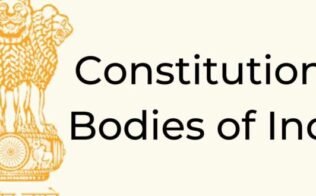Constitutional Bodies of India are called so because the Indian Constitution specifies how they are formed. The Indian Constitution gives them the authority and power they need to carry out their duties. Such entities usually need a constitutional amendment to modify their powers or activities. The Indian Constitution gives the constitutional bodies their authority; therefore, any change in their structure would also need a constitutional amendment.
It is important to distinguish constitutional bodies from statutory bodies. Since statutory bodies are established by legislation, but constitutional bodies of India are established under the Constitution of India.
[ias_current_affairs_cta]
Constitutional Bodies of India
1. Finance Commission
Article 280 of the Indian Constitution establishes a quasi-judicial body to oversee the government’s finances. Every five years, the President appoints a new board. In 1951, KC Neogy was appointed head of the 1st Finance Commission. The President appoints a Chairman and four other members, all subject to re-appointment.
Functions of the Finance Commission
- Consolidated funds of a state are evaluated to assign the state’s resources to the municipalities and panchayats of the state.
- It has the authority to make recommendations about the rules that govern the allocation of federal funds to the states from the country’s Consolidated Funds.
- Financial powers are as extensive as those held by a civil court in this nation.
2. Comptroller and Auditor General
An independent CAG office is provided for under Article 148 of the constitution, and he heads the Indian Audit and Accounting Service. He is in charge of the country’s whole financial system, from the federal level down to the state level. He is the Parliament’s Public Accounts Committee’s friend, philosopher, and advisor.
The President appoints the members of CAG. Typically, this position is filled by someone with extensive administrative expertise and understanding. Six years, or until he is 65, whichever comes first, is the maximum term of office. The President has the power to dismiss him for the same reasons and in the same way as he may remove a Supreme Court judge.
Functions of Comptroller and Auditor General
- He makes sure that the Parliament’s appropriations aren’t exceeded without sanction.
- Comptroller and Auditor General conducts an audit of all government spending, including that of the federal and state governments, to ensure that funds are spent in accordance with the law.
- As a governmental auditor, he examines government-funded organisations’ financial records, including public sector firms.
Read More: Basic Structure Doctrine of Indian Constitution
3. Attorney General of India
As stipulated by Article 76 of the Constitution, India has the position of Attorney General. He is the country’s highest-ranking lawyer and first law officer, and the President appoints him. If anyone wants to be Attorney-General, he must meet the Supreme Court’s judge criteria. He is eligible to participate in Parliamentary sessions. He is, however, denied the opportunity to participate in parliament to cast a vote.
Functions of an Attorney General
- He handles legal problems addressed or assigned to him by the President as India’s main legal counsel.
- In issues involving the Indian government, the Attorney General stands before the Supreme Court and different High Courts.
4. Election Commissioner
Article 324 of the Constitution specifies that the authority of superintendence, direction and supervision of Election to Parliament, Legislature of the state, the office of President and VP should be in the hands of Election Commission. The state election commission takes care of the elections to panchayats and municipalities.
The Election Commission shall comprise the CEC and two additional election commissioners as the President may appoint from time to time. They hold office for 6 years or until they acquire the age of 65 years, whichever is sooner.
Functions of Election Commissioner
- Determination of the territorial areas relating to the electoral constituencies in India.
- Registration of all the eligible voters and the modification of electoral rolls periodically
- Granting status and election symbols to political parties
- Advising president on matters relating to disqualification of MPs
5. Union Public Service Commission
On October 1st, 1926, the first Public Service Commission was established. Yet on January 26, 1950, it was officially recognised as a constitutional body. As a result, the Union Public Service Commission, or UPSC, was created. Members of the Union Public Service Commission report to a Chairman. Those who the President chooses. It is expected that the chairman and members of the commission would keep their positions for a period of six years or until they reach the age of 65, whichever comes first.
Functions
- It is in charge of administering tests/exams for appointments to union services, such as IAS, central, and public services in union territories’ areas.
6. State Public Service Commission
In 1935, the Government of India Act stated that the Provincial Public Service Commission would be referred to as the State Public Service Commission when it was established. Furthermore, it was indicated that the SPSC would be granted constitutional standing. It is widely regarded as the state’s watchdog of the state’s merit system by the SPSC. The governor appoints a chairperson and other members, and the governor has the final say on the number of additional members. If you’re under the age of 62 at the time of your appointment, you’ll serve for six years.
Functions
- The SPSC is responsible for conducting all state service examinations.
- The SPSC handles all disciplinary issues involving a person in a civil capacity.
Articles 315-323 of the Constitution deals with matters of UPSC and SPSC. Now, let’s see some more Constitutional Bodies of India.
7. National Commission for SCs
Article 338 of the constitution establishes it. In the beginning, there was just one commission for SCs and STs, but now there are two. However, in 2003, the 89th Amendment to the Indian Constitution split it into two different bodies. Thus, in 2004, a separate National Commission for SCs was established. The president appoints a chairperson, a vice-chairperson, and three more members.
Functions
- To look into the different protections that are in place for SCs.
- Complaints on the denial of rights of SCs are to be investigated.
- An advisory role for the socio-economic development of SCs is required.
8. National Commission for STs
Art. 338-A of the Constitution of India lays out the rules. The 89th Amendment Act of 2003 added a new section 338-A to the Constitution. Because of this, an ST commission was established in 2004. The president appoints the chairman, the vice-chairperson, and the other three members.
Functions
- Inquiry into the different protections for STs that are available to them.
- To investigate the complaints of STs regarding the denial of their rights.
- Assist in the development of STs’ socio-economic futures.
- To report on the effectiveness of different protections to the president.
Read More: PM Launches Swachh Bharat Mission
9. Special Officer for Linguistic Minorities
The States Reorganization Commission mandated the creation of this office. An amendment made by the Seventh Amendment Act of 1956 included a new article 350-B to Part VII. The president appoints the Special Officer for Linguistic Minorities. Allahabad is the Commissioner’s headquarters, with regional offices in Belgaum, Chennai, and Kolkata.
Functions of the Officer/Commissioner
- The Commissioner is responsible for addressing any complaints about the different protections for linguistic minorities.
- Linguistic minorities deserve equitable access to the Commissioner’s efforts.
10. National Commission for Backward Classes
A constitutional body was established for the NCBC with the 102nd Constitutional Amendment Act of 2018 (the “Act”). Article 338-B was added to the constitution as a result of this amendment. The National Commission for Backward Classes (NCBC) was established in 1993 by the National Commission for Backward Classes Act. Chairperson, Vice-Chairperson, and three other members make up the group’s membership. The president appoints them.
Functions
- To learn more about the numerous protections offered to socially and educationally marginalised groups.
- To guide the advancement of socially and educationally underserved groups in economic and social progress.





